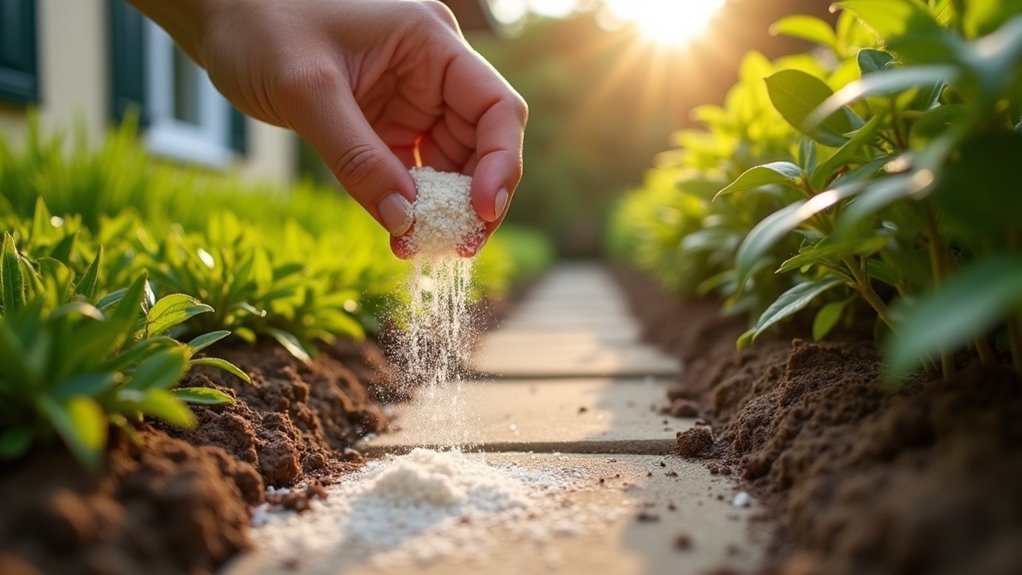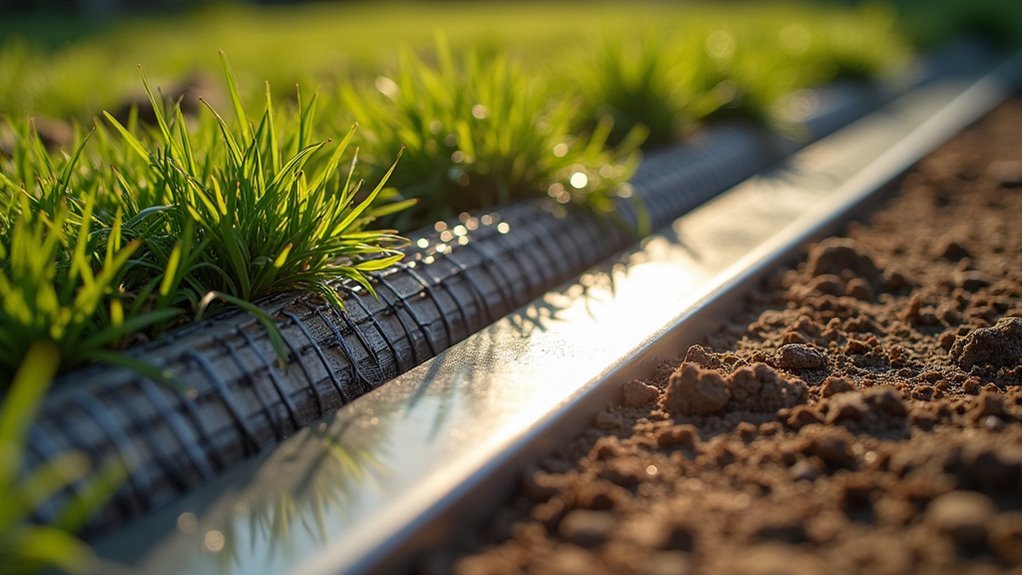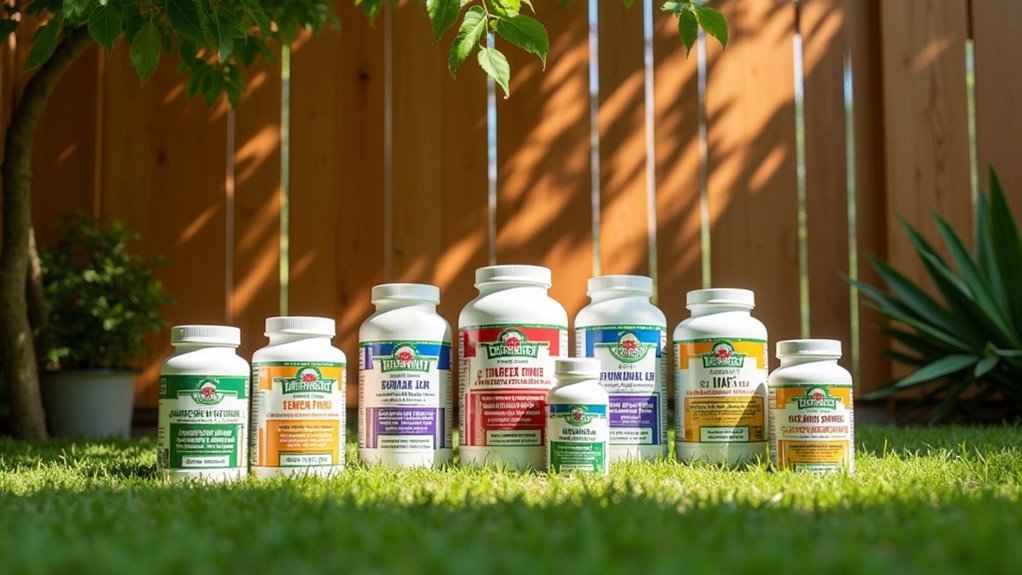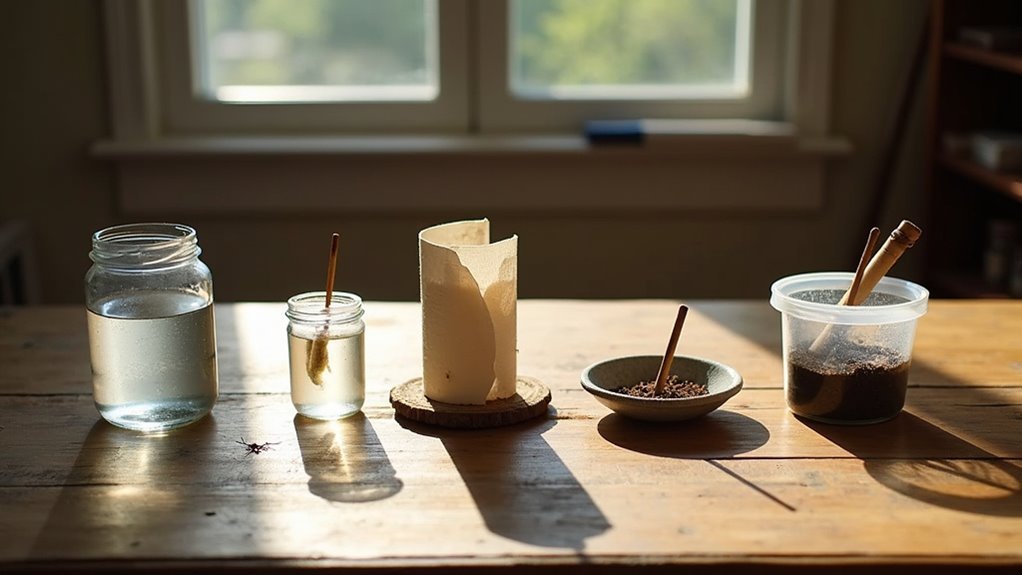You can create effective non-toxic termite barriers using sand foundations, diatomaceous earth around wood piles, and boric acid treatments that disrupt termite digestive systems. Install metal shields in foundation cracks, deploy beneficial nematodes in soil, and use cardboard traps with cellulose bait. Heat treatments reaching 120°F and proper drainage management eliminate moisture that attracts termites. These natural methods reduce termite activity by up to 90% while keeping your family safe. Discover how each technique works together for maximum protection.
Moisture Control and Drainage Management

Since termites thrive in moist environments, you’ll want to eliminate excess moisture around your home as your first line of defense. Proper drainage systems are essential for termite prevention, as they divert water away from your foundation and prevent accumulation that attracts these destructive pests.
Eliminating excess moisture around your home serves as the most effective first defense against termite infestations.
Keep soil levels 6 to 18 inches below wooden structures to prevent direct contact between termites and wood. This gap creates a barrier that’s harder for termites to cross while reducing moisture retention near vulnerable areas.
Regularly inspect your landscaping to make certain water doesn’t pool near your foundation. Fix leaky gutters, downspouts, and irrigation systems promptly.
Consider installing sand barriers around your foundation, as sand doesn’t retain moisture like soil, effectively deterring termites from accessing your home’s wooden components.
Sand Barrier Installation Around Foundation
Installing a sand barrier around your foundation builds on the moisture control principles you’ve already established.
You’ll want to create a sand barrier that extends 6 to 18 inches below any wooden components to effectively prevent termites from reaching your foundation. Sand doesn’t retain moisture, keeping the area dry and reducing termite attraction.
This cost-effective solution can be easily implemented around your home’s perimeter.
You’ll need to maintain the barrier regularly to guarantee it remains intact against termite infiltration.
When installing, be careful that your landscaping and sprinkler systems don’t create moisture accumulation near the foundation.
Proper installation means keeping the sand dry and monitoring for any gaps that might compromise your termite defense system.
Diatomaceous Earth Application

Food-grade diatomaceous earth offers another powerful weapon in your non-toxic termite prevention arsenal. This fossilized algae powder works as an effective termite control treatment by dehydrating termites upon contact.
Food-grade diatomaceous earth provides a natural termite defense by dehydrating pests on contact without toxic chemicals.
You’ll want to sprinkle DE generously around wood piles, foundations, and potential entry points where termite activity occurs. Keep the powder dry for maximum effectiveness, as moisture reduces its ability to eliminate termites. Reapply after rain or heavy moisture exposure.
Food-grade DE remains safe for your family and pets while proving lethal to pests. Regular inspections and fresh applications create a preventive barrier against future termite infestations.
This natural approach complements other non-toxic methods, providing continuous protection around your home’s vulnerable areas without introducing harmful chemicals into your environment.
Boric Acid Wood Treatment
You can apply boric acid as a wood treatment using two primary methods: spraying a diluted solution directly onto wood surfaces or mixing it with water for brush application.
This versatile approach works effectively for both preventing termite infestations and treating existing problems in wooden structures.
Understanding proper application techniques and safety protocols will help you maximize boric acid’s effectiveness while ensuring safe handling throughout the treatment process.
Application Methods and Techniques
When applying boric acid as a wood treatment, you’ll achieve the best termite control by using a 5-10% concentration mixed with water. This termite treatment requires proper application methods to effectively kill termites and protect your home.
Follow these essential application methods:
- Surface Application – Spray or paint the boric acid solution directly onto exposed wood surfaces where termites are active.
- Deep Penetration – Drill small holes into infested wood and inject the solution to reach hidden termite colonies.
- Safety Gear – Wear gloves and a mask during application to prevent respiratory irritation and skin contact.
- Regular Maintenance – Reapply the treatment periodically, especially in moisture-prone areas, to maintain long-term effectiveness.
This systematic approach guarantees thorough termite elimination while maintaining safety standards.
Safety and Effectiveness
Boric acid’s effectiveness as a termite treatment stems from its ability to disrupt the insects’ digestive systems while maintaining remarkable safety for your family and pets.
When you apply this natural insecticide to wood surfaces, it penetrates deeply, creating long-lasting protection without harmful chemicals typical in conventional termite treatments.
You’ll find boric acid delivers consistent results when properly diluted at a 1:10 ratio with water. This non-toxic pest control method won’t pose health risks to humans or animals when used as directed, making it superior to toxic alternatives.
For best results, you should monitor treated areas and reapply the effective treatment every few years.
This maintenance schedule guarantees continued protection against infestations while preserving your home’s safety standards.
Metal Shield and Physical Barriers

Although chemical treatments dominate the termite control market, metal shields and physical barriers offer a proven, non-toxic alternative that creates an impenetrable defense around your home’s foundation.
These physical barriers effectively address termite problems by forcing insects to tunnel externally where you’ll easily spot their activity.
Professional installation guarantees maximum effectiveness through these key benefits:
- Foundation Protection – Metal shields fill cracks as small as 1/32 inch, preventing termite entry into your structure.
- Moisture Control – Unlike chemical treatments, these barriers don’t retain moisture that attracts termites.
- Professional Assessment – Experts identify foundation and floor breaches for thorough coverage.
- IPM Integration – Physical barriers enhance long-term protection when incorporated into broader pest management strategies.
Essential Oil Repellent Solutions
You’ll find essential oils offer a powerful, non-toxic alternative to chemical termite treatments when applied correctly around your home’s vulnerable areas.
Neem oil works exceptionally well when you inject it directly into wooden structures or create protective paste barriers around potential entry points.
Citrus oils like orange oil and clove oil containing eugenol provide immediate contact killing power when you spray them directly on termite colonies or infested wood surfaces.
Neem Oil Application Methods
When dealing with termite infestations, neem oil offers one of nature’s most effective deterrent solutions through its active compound azadirachtin, which disrupts termites’ reproductive and feeding systems.
This natural repellent provides multiple application methods to protect your home.
Here’s how to apply neem oil effectively:
- Spray Application: Mix neem oil with water at a 1:10 ratio in a spray bottle, targeting wooden structures and suspected termite areas.
- Enhanced Coverage: Add liquid soap drops to your mixture, creating better surface adhesion and improved coverage.
- Direct Injection: Inject neem oil directly into infested wood for focused treatment with minimal chemical exposure.
- Regular Maintenance: Reapply every few weeks to maintain protection, as neem oil biodegrades naturally without harmful environmental residues.
Citrus Oil Effectiveness
Building on natural termite control methods, citrus oils offer another powerful weapon in your non-toxic arsenal. The d-limonene in orange oil kills termites on contact by disrupting cellular membranes, causing dehydration and death.
You’ll find citrus oil particularly effective when combined with clove oil and neem oil for enhanced repelling action.
Mix citrus oil with water and spray directly onto affected wood and surrounding areas. This non-toxic treatment won’t harm your family or pets while providing powerful termite control.
However, don’t rely solely on citrus oils – they work best within an integrated pest management approach. Regular inspections and moisture control amplify their effectiveness.
Consider consulting a termite professional to develop a thorough strategy incorporating these natural solutions.
Clove Oil Treatment
Among the most potent essential oil treatments, clove oil delivers exceptional termite control through its active compound eugenol, which disrupts feeding and nesting behaviors while penetrating deep into wood structures.
This non-toxic solution can reduce termite activity by up to 90% when properly applied as part of your treatment program.
You’ll maximize clove oil effectiveness by following these application steps:
- Dilute the oil according to manufacturer instructions for safe household use
- Apply directly to infested areas and wood surfaces where termites concentrate
- Reapply regularly to maintain protective barriers in termite-prone zones
- Focus treatment on foundation areas, wooden beams, and moisture-damaged sections
Since clove oil remains safe around humans and pets, you can confidently prevent termites without exposing your family to harmful chemicals while maintaining long-term protection.
Heat and Cold Treatment Methods
Two powerful temperature-based methods offer homeowners effective, non-toxic alternatives to chemical termite control.
Heat treatment eliminates termites by raising infested wood temperatures to at least 120 degrees Fahrenheit for 30 minutes, killing all life stages instantly.
Cold treatment works by lowering temperatures to 15 degrees Fahrenheit for up to four days, disrupting termites’ survival abilities.
Both approaches provide safe residential solutions without health risks to your family or pets.
However, you’ll need specialized equipment and careful monitoring to guarantee effectiveness, as improper application may leave some termites alive.
These temperature methods work best when you combine them with other preventive measures like regular inspections and moisture control, creating a thorough termite management strategy that protects your home long-term.
Cardboard Trap Bait Systems
While expensive equipment makes temperature treatments challenging for many homeowners, cardboard trap bait systems offer a simple, cost-effective alternative that requires only materials you likely have at home.
These non-toxic traps work because termites can’t resist cellulose, the main component in cardboard.
Termites are naturally drawn to cardboard’s cellulose content, making these homemade traps irresistibly effective against infestations.
Here’s how you’ll create effective cardboard trap bait systems:
- Stack several pieces of moist cardboard in suspected termite-infested areas.
- Monitor the traps regularly for termite activity and colonization.
- Remove infested cardboard and dispose of termites by burning or sealing in bags.
- Replace cardboard as needed to maintain trap effectiveness.
This eco-friendly method keeps your family and pets safe while managing minor termite problems without calling pest control companies.
You’ll identify new infestations early and control existing populations effectively.
Beneficial Nematode Deployment
Beneficial nematodes represent one of nature’s most effective biological weapons against termites, offering homeowners a completely safe yet powerful solution for long-term pest control.
These microscopic roundworms specifically target termites by entering their bodies and releasing deadly bacteria that kills them within 24-48 hours.
You’ll find beneficial nematodes are an eco-friendly option that won’t harm your family, pets, or plants. For ideal results, apply approximately 1 million nematodes per 100 square feet during warm, moist conditions when they’re most active.
What makes nematodes particularly valuable is their ability to control termites long-term. They reproduce naturally in soil, establishing a permanent biological defense system against future termite infestations without requiring repeated chemical treatments.
Soil Grading and Landscape Modifications
Although chemical treatments often grab attention, proper soil grading and strategic landscape modifications create the foundation of effective termite prevention by eliminating the moisture conditions these pests need to thrive.
You’ll want to implement these key landscaping modifications:
- Slope soil away from your foundation – Maintain proper soil grading to prevent moisture accumulation around your home’s perimeter.
- Create buffer zones – Keep mulch and wood piles at least 12 inches from your foundation walls.
- Install drainage systems – French drains redirect water away, reducing termite infestation risks.
- Use sand barriers – Sand doesn’t retain moisture like soil, creating an inhospitable environment for termites.
Don’t forget to adjust sprinkler systems to avoid oversaturating foundation areas.
These simple modifications eliminate the wet conditions termites require.
Frequently Asked Questions
What Is the Least Toxic Termite Treatment?
You’ll find diatomaceous earth and boric acid are the least toxic termite treatments. They’re safe for humans and pets while effectively killing termites by dehydrating them or disrupting their digestive systems naturally.
What Is the Best DIY Termite Treatment?
You’ll find diatomaceous earth works best for DIY termite treatment. Sprinkle it directly on infested areas where it’ll dehydrate termites on contact. It’s non-toxic, effective, and doesn’t require special equipment or mixing.
Can You Get Rid of Termites Without Chemicals?
You can eliminate termites without chemicals using heat treatment, cold exposure, diatomaceous earth, or boric acid. Physical barriers like sand and metal shields prevent infestations, while controlling moisture deters termite activity naturally.
Can You Do a Termite Barrier Yourself?
You can create termite barriers yourself using sand barriers, Pango Wrap installation, salt solutions, sealing cracks with caulk, or spreading diatomaceous earth around your home’s perimeter for effective protection.
In Summary
You’ve now got ten proven, non-toxic methods to create effective termite barriers around your home. Start with moisture control and soil grading since they’re foundational to prevention. Then implement physical barriers like sand installation and metal shields for immediate protection. Don’t forget biological solutions like beneficial nematodes for long-term control. Combine multiple strategies for maximum effectiveness, and you’ll maintain a termite-free home without harmful chemicals threatening your family’s health.





Leave a Reply